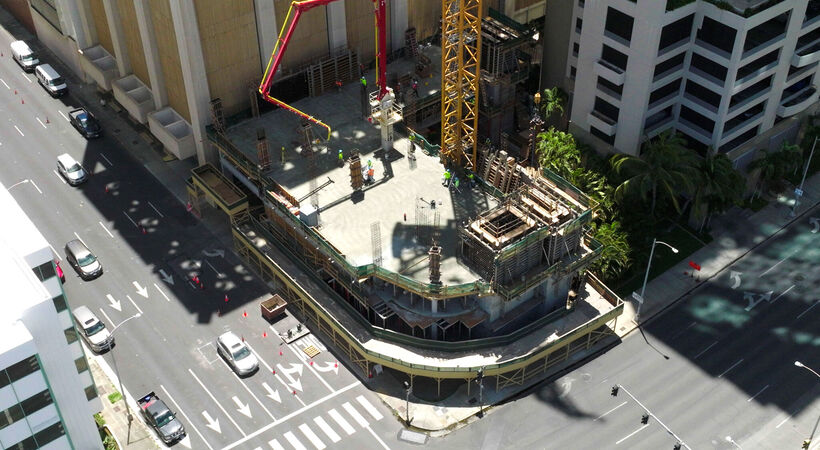René Morkos, founder of ALICE Technologies says that time is money and large-scale construction projects are prone to delays, which can quickly add up to even larger costs.
Corporate disputes and claims arising from project delays have risen dramatically in recent years. In one 2021 survey, 75% of respondents reported damages incurred - at a whopping average of $54.26 million. According to independent research firm Arcadis, most of those delays could be attributed to a failure to adapt quickly to changes in site conditions or disruptions to schedule, which means, ultimately, that most delays are avoidable. While there are certainly commonalities, the specific risks and challenges faced by any particular project are individual to the environment, site conditions, and project design. Reacting to issues and delays as they occur can leave owners and GCs scrambling to preserve slim profit margins, avoid liquidated damages, and circumvent disputes.
Unique circumstances call for unique solutions - and without a well-considered response, unforeseen issues can derail a project entirely.
Ecological disasters, international conflict, adverse weather, supply chain issues, labor shortages, equipment malfunction - the list of challenges affecting on-time delivery is vast, and impossible to predict - and the longer the project timeline, the larger the risk. When unexpected obstacles crop up (as they inevitably will), here are some best practices to help you respond quickly and effectively.
Anticipate challenges
During your pre-construction assessment, identify critical dependencies and areas of high risk, noting vulnerabilities with high impact to cost or schedule. Include these in your contingency plan, and develop best-practice methods for communication, workaround, and recovery. Thinking proactively about high-impact events (even if they may seem far-fetched) in addition to more common challenges can help both GCs and owners anticipate the unexpected, mitigate risk, and avoid costly damages and disputes. A good project recovery plan takes into consideration scheduling, scope of work, financial obligations, resource management and site details. It should also take into account possible points of failure, in order to predict and mitigate risk. Swift and precise action is the only way to get your project back on track, and this type of advance planning can help GCs and developers avoid accruing extensive damages.
Categorize and prioritize
Once stakeholders have identified and assessed potential challenges, those challenges should be categorized by level of risk and/or critical dependencies, then prioritized accordingly. Issues likely to affect the construction timeline or postpone the project delivery date are also most likely to trigger damages, and should be considered carefully. Proactively prioritizing potential critical delays can help GCs envision and design effective recovery scenarios. Changes that may impose additional costs or unplanned expenses to the owner or contractor can be factored into project recovery and contingency planning, and addressed with greater speed and confidence.
Use smart scheduling tools
Many traditional schedulers and planners rely on the Critical Path Method - but for construction recovery, CPM tools are limited in their flexibility and usefulness. The best scheduling tools reduce manual entry, improve project insight, and offer greater flexibility and accuracy. When the unexpected arises, these qualities are crucial; cumbersome software reliant on CPM will only slow the process, while the use of more modern scheduling software and tools can streamline project recovery. Smart scheduling and sequence optimization can help GCs evolve to meet shifting conditions, avoid incurring damages, and realign a complex build - quickly.
Manage timelines proactively
In a complex system full of moving parts, even slight deviations can set off a chain reaction which impacts project success. Speed is key to correcting problems that might cause cascading effects and completely derail your construction timeline.
Detailed, continuous oversight and schedule management can keep your project on track, and ensure important milestones are met. Without vigilant attention, even excellent recovery plans fail - and slipped tasks can snowball into collapsing deadlines and avalanching delays.
Realign your baseline schedule
On large-scale projects, it's impossible to anticipate every disruption. At the first sign of trouble, reassess the baseline schedule to gain a clear sense of required adjustments.
When complex dependencies are at play, an AI-based tool for construction schedule optimization can save time and resources, realigning sequencing and scheduling in real-time. Current site conditions are analyzed swiftly and efficiently, and organized into visualizations that help construction teams understand how project changes affect overall outcomes. This clarification often unveils opportunities for optimizing project scheduling and sequencing, revealing new pathways for maintaining project momentum. Consider smart alternatives
With liquidated damages looming, speed is key to recovery - and GCs and developers often double down on labor in order to maintain slipping deadlines. But what if there was a better way?
Labor is in short supply, these days - which means it also comes at a premium. Throwing additional people at the problem is not necessarily the most effective (or cost-effective) approach - but in order to make smart decisions, GCs and developers need to pause and consider alternatives.
AI-based tools can provide models of existing data, and simulate new strategies and scenarios in order to assess their impact. By demonstrating the use of two cranes instead of one, or reconfiguring construction sequences around material staging and site-flow efficiency, new strategies and approaches are developed - and projects can often be recovered without excessive time and labor costs.
Plan for the unexpected
Some events are simply unpredictable. Labor strikes, natural disasters, resource shortages, government interventions, and concealed conditions… With so many interdependent tasks, avoiding construction project delays entirely requires nothing short of a miracle. But while some delays may be inevitable, claims and disputes can often be circumvented or mitigated through thorough planning.
When even the best-laid plans fail, AI-driven software for construction project scheduling and optimization, such as ALICE Technologies, can help you adapt quickly - analyzing delays triggered by unpredictable occurrences, so your team can adjust to meet changing conditions. Swiftly incorporate new information, model the best pathway forward, and update and communicate project plans effectively - and you’ll find your delayed projects recover at lightning speed.

